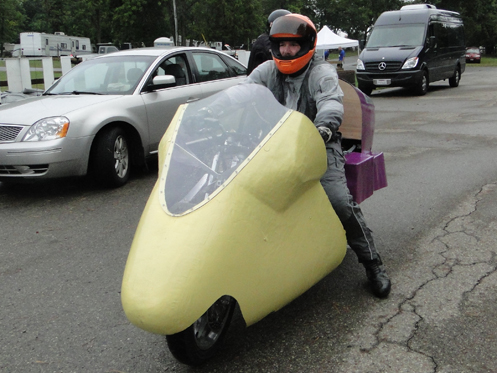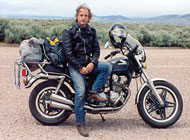Racing: A Prod And An Impediment To Motorcycle Development
Racing has a long history of pushing motorcycle development forward, as solutions to punishing conditions on the track migrate to street bikes to make them better and better.
What is less well known is how some areas of motorcycle development have been blocked by the rules promulgated by the powers that be in racing. Specifically, today’s motorcycles would probably be a lot more aerodynamic were it not for limitations imposed by racing.
Craig Vetter is renowned for his fairing designs as well as a lot of other work on motorcycles. As Grand Marshal at the American Motorcyclist Association’s Vintage Motorcycle Days a few weeks ago, he also hosted the Craig Vetter Fuel Economy Challenge. The Challenge solicits entries of bikes that can move at highway speed while getting the greater mileage based on fuel cost, all the while serving as a viable alternative to a car. As the key to meeting that last demand, the bikes are required to be able to carry four bags of groceries.
In the presentation he gave on the purposes of the challenge, Vetter also covered some history that had much to do with why motorcycles look the way they do today. Following World War II, he said, German, Italian, and Japanese designers worked to make motorcycles more aerodynamic, and therefore more economical. The designs they were coming up with looked a lot like the designed used today on the bikes that go to the Bonneville Salt Flats to set land speed records. That is to say, they have a rounded nose and come to a point in the rear, with smooth body paneling over the rest of the bike.
Said Vetter, “They were looking . . . not like what you could buy. Remember the old adage, ‘Win Sunday, Sell Monday’? That’s what motorcycle dealers said. Well, these motorcycles didn’t look like anything you could buy on Monday. And so the FIM, which was the world sanctioning body for racing at that time, was under pressure from the people with money–motorcycle manufacturers–to eliminate streamlining. Now, they could have said, ‘You motorcycle manufacturers, you should change your ways,’ but they didn’t. They bowed to the pressure of the motorcycle industry of the time, and this is what they did. This is why the motorcycles on the track out here today look like they do and do not look like real streamliners, which is very significant.
“We already know that this is real streamlining (showing slide of round-nosed, pointed tail, enclosed body bike). It only takes 3 horse power to take you 60 miles an hour. Here’s what the FIM did with their rules. In one sweep at the end of 1956 they said, ‘Oh, you’ve got to see the front wheel. Oh, you’ve got to cut it all off in front of the axle. You can’t have anything sticking in front of the front axle. Oh, you can’t have anything sticking behind the rear wheel either, behind the rear axle. This is now illegal. Plus, you’ve got to see the rider from the side, everything, you can’t cover him up. You’ve got to see the rider totally from the side. The back end can’t be high either. You’ve got to cut it off 5 inches high. You can’t have anything on the back. The fairing can’t slope any more than 30 degrees.’
“And that’s what we have on the track today. They intentionally gave us dumb streamlining. They could have said, ‘No, we want technology to advance. We’re gonna require tracks to be better, to handle faster speeds.’ They could have said, ‘Hey you guys have got to come up with better brakes. You guys gotta come up with better cooling.’ But they didn’t. They intentionally slowed motorcycles down and made them . . . made it hard to go fast.”
Now you know.
Recent from National Motorcycle Examiner
Demo riding the 2013 Victory Hammer 8-Ball
Biker Quote for Today
What in the wide, wide world of sports is a-goin’ on here?

